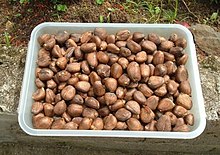Saltibus
| Saltibus Saltibus |
||
|---|---|---|
|
|
||
| Coordinates | 13 ° 48 '2 " N , 60 ° 59' 57" W | |
| Symbols | ||
|
||
| Basic data | ||
| Country | St. Lucia | |
| Laborie | ||
| ISO 3166-2 | LC-07 | |
| height | 241 m | |
| surface | 44.3 km² | |
Saltibus is a place in the southwest of the island of St. Lucia in the Quarter Choiseul .
geography
The village is located in the northeast of the main town Choiseul and northwest of Laborie im Bergland at an altitude of approx. 241 m . The surrounding rainforest is rich in water and the soils are fertile. The main attraction of the place is a series of waterfalls with heights between 3 and 10 m. There is also a dam that supplies Saltibus and some neighboring towns with drinking water. The economy is mainly agricultural. Outstanding mountains in the area are Mount Belvidere and Mount Grand Magazin , as well as Mount Cok . Well-known rivers are Saltibus River , Daban River , Saltibus Cold Springs, and Daban Springs .
climate
The weather in Saltibus is tropical temperate and determined by the Northeast Trade Winds. There is a dry season from January to April and a rainy season from May to August.
Attractions
The Saltibus Waterfall Trail near the village leads through the rainforest to the Saltibus Waterfalls . Five cascades with heights between 3 and 10 m pour down into the valley here.
population
The population of Saltibus is mainly of African or mixed African-European descent, with some Indians and European minorities. English is the official language and there are French and patois . The vast majority are Catholic . There are a total of around 1690 residents in various settlements and residential areas such as Daban , Park Estate , Gayabois , Gertrine and Giraud .
Festivals
La Woz (Rose) and La Magwit (Marguerite) are the names of two competing 'societies' that have a special tradition of 'festivals'. La Woz represents Rosicrucian and La Magwit Freemasonry . Preparations for the annual festivals begin several months before the festival day. Each group holds “ seances ”. In this case, these are singing and dancing events at night, where drinks are sold and games are played.
The central figure of these seances is the shatwel ( lead singer ), who controls the “spirit and tenor” of the event. Many groups have a special excellent shatwel . These are usually women.
On the festival day, all members of the respective societé dress in their respective roles in the gala rooms and visit the church for a service that precedes the parade through the streets before they go to the festival hall for the grande fete .
A well-known painting that represents this tradition is a mural by Dunstan St. Omer , in which he depicted the trinity of Osiris , Horus and Isis .
A carnival is traditionally held in conjunction with Mardi Gras in the week before Lent begins.
literature
- The Library of Congress Country Studies lcweb2.loc.gov
- Daniel J. Crowley: La Rose and La Marguerite Societies in St. Lucia. In: Journal of American Folklore. vol 71, 282 October – December 1958: pp. 541–552. doi = 10.2307 / 537460 | jstor = 537460
- Patrick AB Anthony: The flower festivals of St. Lucia . Folk Research Center: St. Lucia Media 1985. stluciafolk.org
Web links
- La Rose and La Marguerite Societies in St. Lucia
- Current Weather Report in Saltibus, Saint Lucia
- World — Country Profiles
- Saint Lucia Government Statistics Department
Individual evidence
- ^ Map at Travelingluck.com.
- ↑ freemeteo.com .
- ↑ freemeteo.com .


